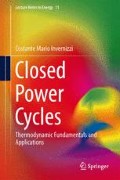Abstract
This chapter, preliminary to the subsequent chapters, summarises the thermodynamic properties of fluids, illustrates the Law of Corresponding States and define a parameter of molecular complexity for each working fluid. The chapter then discusses the influence of the compressibility, of the molecular complexity and of the molar mass of the working fluid on the properties of primary interest for the analysis of the thermodynamic cycles and on the basic design aspects of turbomachines (work compression and expansion, heats of evaporation and vapour pressure). In the case of non-azeotropic mixtures it is shown, with an example, how the temperature and pressure of the critical point of the mixture vary with the composition. The variation of the critical point can in fact be a helpful additional parameter available for the design of closed cycles which are discussed in the following chapters.
Access this chapter
Tax calculation will be finalised at checkout
Purchases are for personal use only
Notes
- 1.
A critical point also exists for fluid mixtures, although, for a prefixed composition, it is not usually the point on the saturation dome at the maximum pressure and temperature (see, for example[1, p. 306]).
- 2.
The phase transition is said to be of the first order if, in the transition point, the derivatives of the chemical potential show discontinuity of the first kind.
- 3.
The difference between specific entropies, multiplied by the temperature at which the phase transition takes place is the latent heat of evaporation.
- 4.
Johannes Diderik van der Waals (1837–1923). In his degree thesis, in 1873, he provided a semi-quantitative description of the phenomena of condensation and the critical point and derived the equation which bears his name. The equation of state which he developed derives from one describing the behaviour of an ideal gas, corrected in order to take into account the two special aspects of a real gas: the finite dimensions of the molecules and the intermolecular forces of attraction. In 1880, van der Waals also derived the Law of Corresponding States, showing that the equation of state which he had formulated could be expressed in a completely general form, by substituting the coefficients a and b, specifics of every fluid, with two universal parameters that are independent from the compound being considered.
- 5.
An azeotrope is a mixture of two or more substances with a composition that cannot be distilled. That is, the glide temperature at constant pressure is null and the mixture behaves, from this point of view, as if it were a pure fluid. The composition of the liquid phase is the same of the composition of the vapour phase.
References
Smith JM, van Ness HC (1975) Introduction to chemical engineering thermodynamics, 3rd edn. McGraw-Hill Kogakusha, Tokyo
Gyftopoulos EP, Beretta GP (2005) Thermodynamics. Foundations and applications. Dover, Mineola, NY
Deiters UK, De Reuck KM (1999) Guidelines for publication of equations of state I. Fluid fluids. Fluid Phase Equil 161:205–219
Poling B, Prausnitz JM, O’Connell JP (2001) The properties of gases and liquids, 5th edn. McGraw-Hill, New York
Peng D-Y, Robinson DB (1976) A new two-constant equation of state. Ind Eng Chem Fund 15(1):59–64
Pitzer KS, Lippmann DZ, Curl RF, Huggins CM, Petersen DE (1955) The volumetric and thermodynamic properties of fluids. II. Compressibility factor, vapour pressure and entropy of vaporization. J Am Chem Soc 77(13):3433–3440
Hougen OA, Watson KM, Ragatz RA (1959) Chemical process principle. Part II – thermodynamics, 2nd edn. Wiley, New York, NY
Hirschfelder JO, Buehler RJ, McGee HA, Sutton JR (1958) Generalized equation of state for gases and liquids. Ind Eng Chem 50(3):375–385
Schreiber DR, Pitzer KS (1988) Selected equation of state in the acentric factor system. Int J Thermophys 9(6):965–974
Reynolds WC (1979) Thermodynamic properties in SI. Graphs, tables, and computational equations for forty substances. Department of Mechanical Engineering, Standford University, Stanford, CA
Gross J, Sadowski G (2001) Perturbed-chain SAFT: an equation of state based on a perturbation theory for chain molecules. Ind Eng Chem Res 40:1244–1260
Tester JW, Modell M (1996) Thermodynamics and its applications, 3rd edn. Prentice Hall PTR, Upper Saddle River, NJ
Parry WT, Bellows JC, Gallagher JS, Harvey AH (2000) ASME international steam tables for industrial use. CRTD-Vol. 58. ASME, New York, NY
Johnson RC (1964) Calculations of real-gas effects in flow through critical-flow nozzles. ASME J Basic Eng 86(3):519–526
Angelino G (1973) About the possibility of the occurrence of rarefaction shock waves in fluids. La Termotecnica 27(9):489–494
Brown BP, Argrow BM (2000) Application of Bethe-Zel’dovich-Thompson fluids in organic rankine cycle engines. J Propul Power 16(6):1118–1124
Invernizzi C, Iora P, Silva P (2007) Bottoming micro-rankine cycles for micro-gas turbines. Appl Therm Eng 27(1):100–110
Hicks CP, Young CL (1975) The gas-liquid critical properties of binary mixtures. Chem Rev 75(2):119–175
Ibrahim OM, Klein SA (1996) Absorption power cycles. Energy 21(1):21–27
Casci C (1978) Elements of fluid machines - two phase fluid machines. Masson Italia Editori, Milan (in Italian)
Author information
Authors and Affiliations
Rights and permissions
Copyright information
© 2013 Springer-Verlag London
About this chapter
Cite this chapter
Invernizzi, C.M. (2013). The Thermodynamic Properties of the Working Fluids. In: Closed Power Cycles. Lecture Notes in Energy, vol 11. Springer, London. https://doi.org/10.1007/978-1-4471-5140-1_2
Download citation
DOI: https://doi.org/10.1007/978-1-4471-5140-1_2
Published:
Publisher Name: Springer, London
Print ISBN: 978-1-4471-5139-5
Online ISBN: 978-1-4471-5140-1
eBook Packages: EnergyEnergy (R0)

